As digital editor of BBC Countryfile Magazine, I spend the majority of my working day peering at a computer screen – and sometimes find it difficult to switch off and relax at the end of the day. So when a chance to join a women’s bushcraft retreat in the Highlands pinged into my inbox, I knew this was the dose of nature I craved.
A flight from Bristol to Inverness and a couple of bus rides later, I arrive at the pretty coastal village of Findhorn to join the Wild Woman retreat at Culbin Sands, a forest and nature reserve on the edge of the spectacular Moray Firth.
Host Jennie Martin says the purpose of running a female-only retreat is to give women the opportunity to learn new skills and build their confidence in an uncompetitive and fun environment.
Over an introductory cup of tea, it is clear that within the group there is a varied level of outdoor experience, and some nerves. One woman has cycled and wild camped solo along the west coast of Iceland, while another has never slept in a tent. Despite this, there’s a common thread – we are all looking to escape the stresses of everyday life, learn new skills and immerse ourselves in nature in stress-free and supportive circumstances.
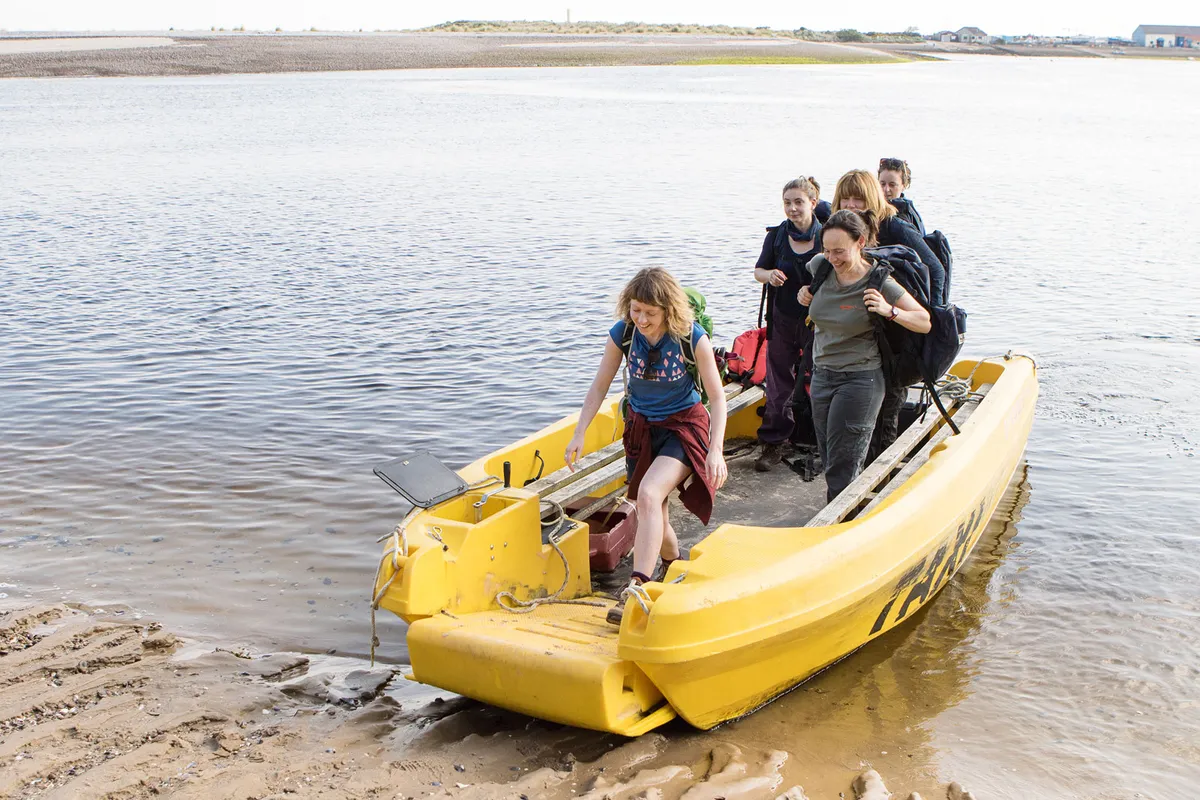
We are all looking to escape the stresses of everyday life, learn new skills and immerse ourselves in nature in stress-free and supportive circumstances.
Boarding a small boat at Findhorn harbour, we make the short journey to our camp for the night. Had harbour seals been basking on the beach, we’d have had to walk through the forest to avoid disturbing them. As there is no sign of them on the sands today, we’re able to land on the beach. Later I’m delighted to spot one or two seals bobbing further out to sea.
Culbin Sands is surrounded by a pristine white sand beach that wouldn’t look out of place in the Mediterranean. As we wander the shore, Jennie gives us a lesson in foraging, and types of edible seaweed. This includes kelp, which has a strong flavour of the sea, and is commonly used as a flavour enhancer in Asian cooking. Laver has a pleasant fishy taste, and is used to make sushi. We also collect gutweed, which we later fry to make an incredibly moreish dish, with a salty, slightly bitter taste.
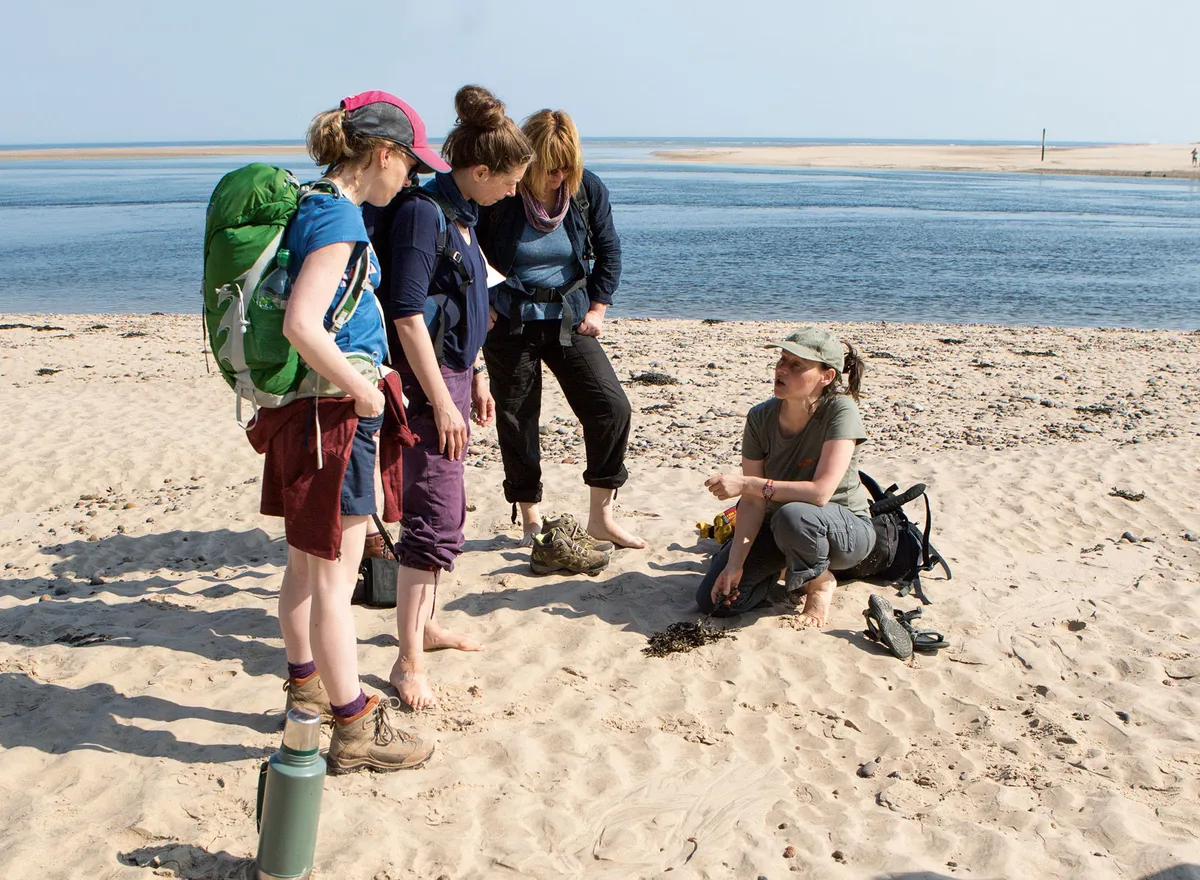
A forest leader and founder of environmental education charity Wild Things!, Jennie has more than 20 years’ experience in bushcraft and forest education. She is also an expert in ethnobotany, with a particular interest in the healing power of plants for both physical and mental health. At the edge of the forest, Jennie urges us to gather the fine yellow pollen from Scot’s pine cones using a paper bag, explaining that the pollen is a potent natural source of the hormone testosterone – and a useful source of energy.

Setting up camp
Scotland is basking in a brief heatwave. I’m glad that I packed my waterproofs, though, as heavy rain is forecast for the evening. Jennie stresses the necessity of preparing for all types of weather when camping out. “Having shelter is an important first job,” she says.
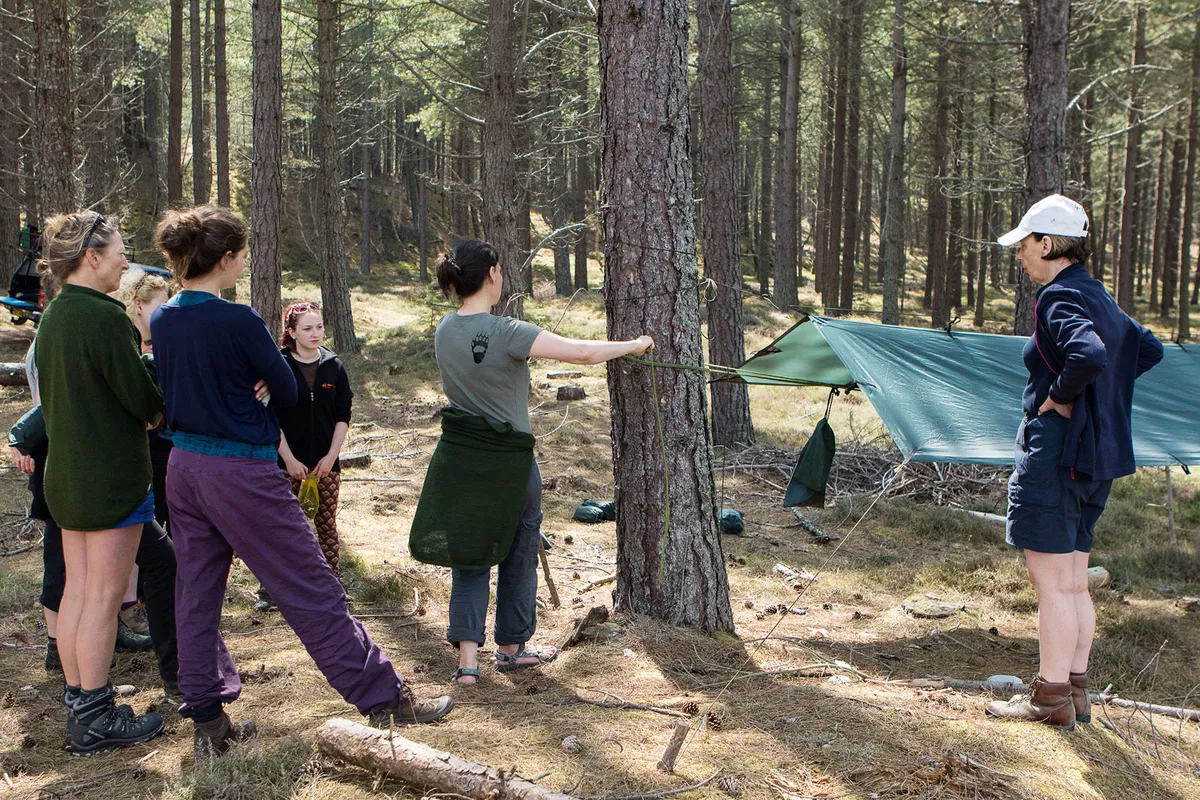
Having shelter is an important first job,” Jennie says.
Setting up camp takes all morning as we first remove tree bracken and debris and then learn the basic knot skills needed to secure the tarpaulins that will protect us from both sun and rain.
To create the camp kitchen, Jennie demonstrates how to throw a tarpaulin ridgeline over a high branch and loop it round the trunk. This is harder than it looks, but after a couple of failed attempts we manage to secure the ridgeline and learn how to use a evenk knot to secure the tarpaulin. An evenk is a useful knot to master as it is strong and secure when fastened, but easy to untie.
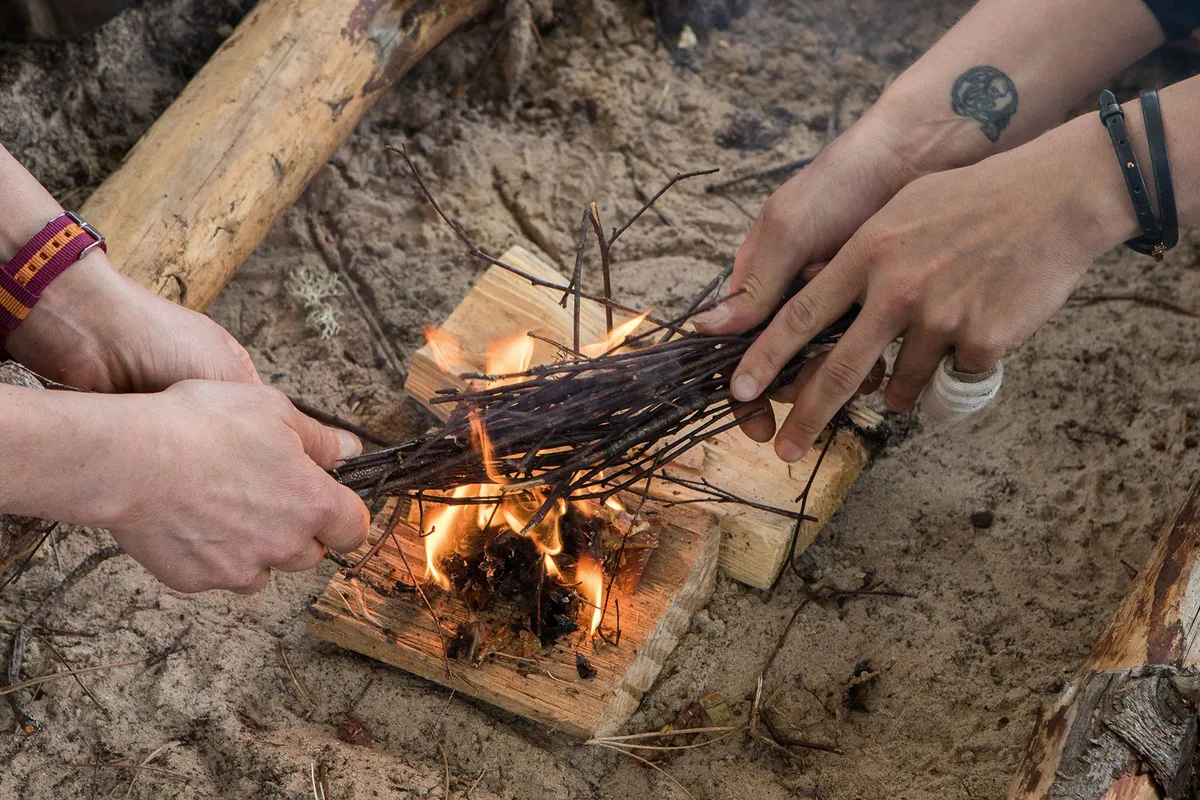
With the food supplies safely stored under cover, we move on to building our ‘leave no trace’ campfire. As a coastal forest, the soil in Culbin Sands is sandy with a low nutrient value, making it hard for plants to grow, so it is vital not to damage this already fragile natural habitat. We use a spade to remove the topsoil, trying to keep it intact so it can be replaced on leaving camp, and dig a shallow pit. Using a small bundle of kindling and thistledown as a natural firelighter, we learn how to use a flint striker. I discover that there is quite a knack to it, as the sharp edge of the flint needs to be struck against the magnesium steel rod at a slight angle to create a spark. This is where the thistledown comes in handy – it catches easily, and unlike matches, the striker can be used even if it gets wet.

Other camp jobs involve digging a toilet pit a distance away from the site (loo paper is collected in a rubbish bag and removed from the site).

Although my knot skills are woefully rusty, I find the task absorbing in its simplicity and the peace of the forest surroundings soon relaxes all of us. We hang hammocks for the night, where I gain a valuable lesson in the importance of tying a evenk knot correctly – as I land in a heap on the mossy floor. A basha (Army slang for a type of waterproof tarpaulin) hangs above the hammock to provide shelter from the rain.
We hungrily tuck into a campfire dinner of grilled fish and tofu with baked potatoes and foraged seaweed. For the first time all day, we have a moment to sit and reflect on the experience. I notice how the group has started to bond as we work together and confidence grows.
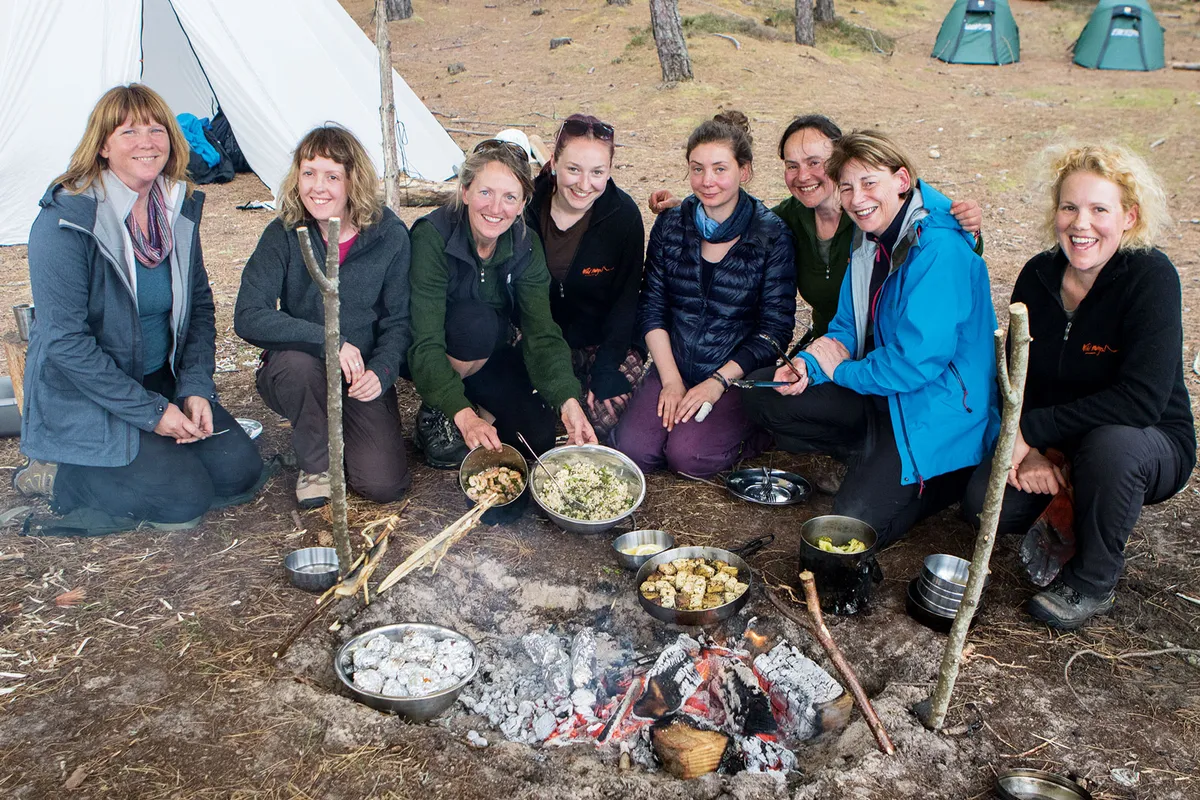
I notice how the group has started to bond as we work together and confidence grows.
The youngest of us, 18-year-old Rosa Kendall, tells me she plans to study for a Walt (Woodland Activity Leader Training) qualification. “It’s really empowering, learning practical skills,” she says. “What I like about this experience is that everyone can go at their own pace and actually have a go.”
NIght glow

Before we turn in for the night, we each create a fire bowl to use as a simple candle holder. Jennie shows us how to place a hot ember from the fire on a piece of wood. She blows gently on the ember, which gradually burns down into the wood, forming a small, smouldering hollow. Finally we use a crook knife to scrape out the ashes; the hollow is just the right size for a candle. This is easily one of the most relaxing and mindful jobs of the day and we all fall into a contented silence, each absorbed in the moment.
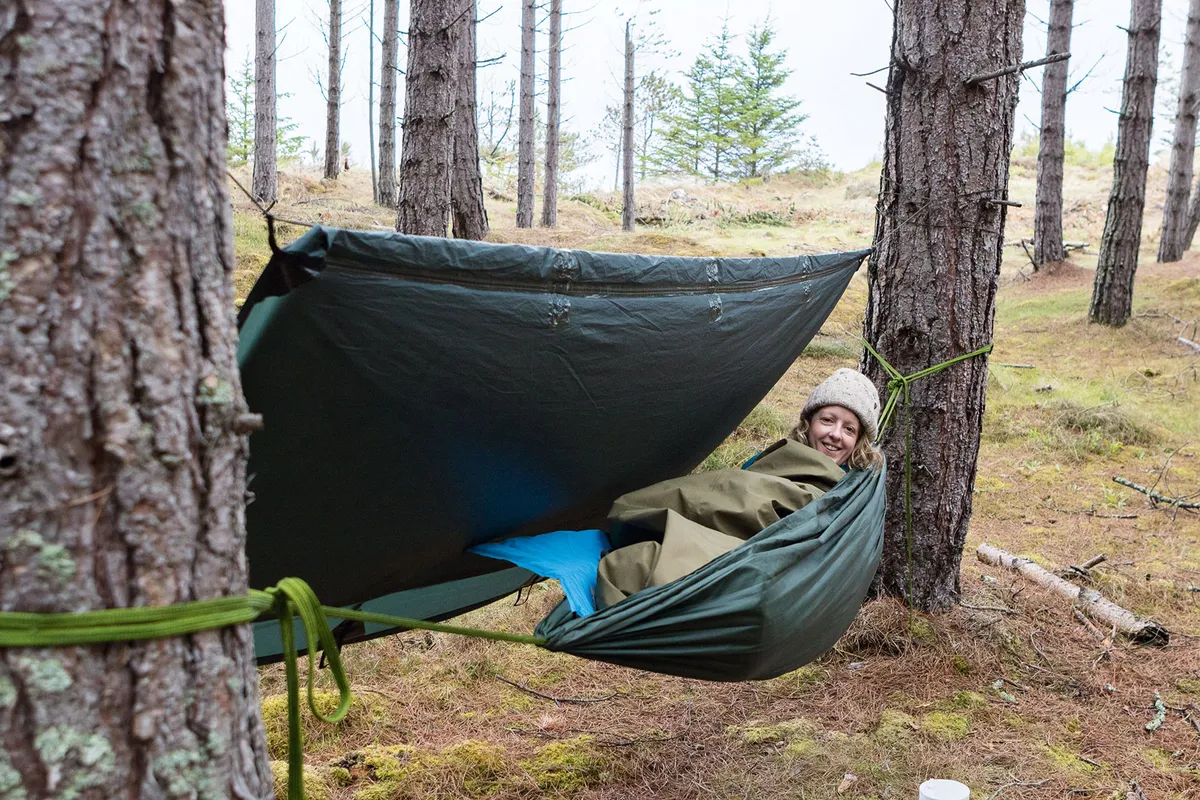
Sleeping under the stars has to be one of the simplest ways to get back to nature. The gentle thud of raindrops hitting the basha overhead soothes me as I sway in my hammock. The scent of wood smoke fills the earthy air and the odd rustle can be heard in the forest undergrowth. After an action-packed day and plenty of fresh air, my usually busy mind is blissfully peaceful as I drift off to sleep.
Wild camping essentials
Some useful items for nights out in the woods, all available in outdoor shops:
- Basha: a lightweight waterproof tarpaulin that provides a basic shelter from wind and rain.
- Sleeping bag: keeps you cosy at night. If you’re planning winter camps, a four-season bag is essential.
- Sleeping mat: can be used in a hammock, bivvy bag or tent, and is worth carrying for a comfortable and warmer night’s sleep.
- Bivvy (or bivi) bag: vital when wild camping without a tent, this waterproof bag covers both your sleeping bag and mat. Look for one made of a breathable fabric – army surplus shops often sell secondhand bags at affordable prices.
- Hammock: keeps you off cold, damp ground and away from forest bugs.
- Parachute cord: heavy-duty cord for hanging tarps and hammocks.
- Fire striker: compact steel tool for lighting a fire in any weather.
- Kelly Kettle: heat water efficiently by burning twigs or other combustibles, such as dry cone, in its base.
- Safety kit: containing insect repellent, any medication you require, first aid equipement, tweezers, and so on.
- Tent: worth packing for use in really poor weather.
- Head torch: keeps hands free for essential tasks.
- Multi-tool: Small tools for 101 camp tasks, in one handy device.
- Water filter: Protect yourself from bacteria in wild water sources.
Women only retreats
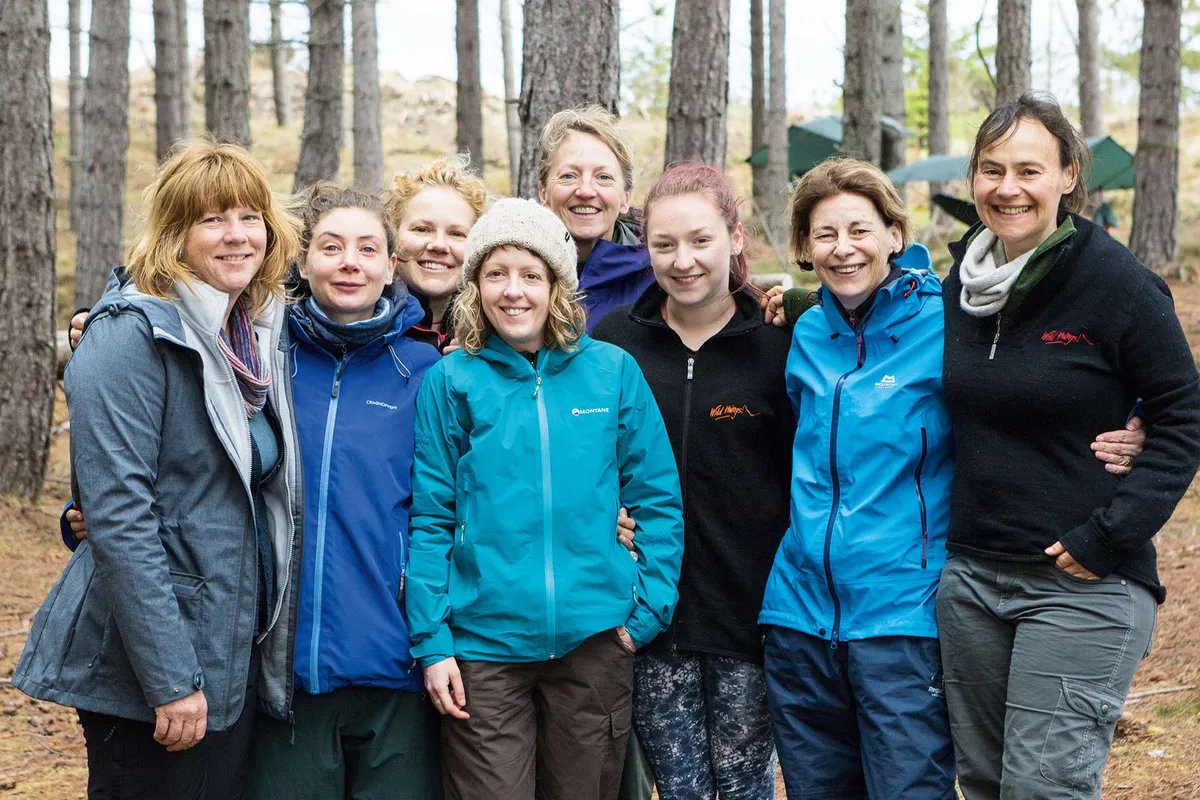
Wild Things!: Wild Woman Weekend
Carys spent the weekend with Jennie Martin, the founder of Wild Things! The environmental education charity offers women’s bushcraft retreats at Culbin Sands, Glen Affric and Spey Descent, where you can learn a range of traditional living skills, such as foraging, camp craft and fire lighting. wild-things.org.uk/our-events/wild-woman

Live Wild: Woodland Women’s Day
Led by Leona Johnson, the course encourages connection with nature and teaches new skills such as whittling, campfire cooking and foraging in woodland surroundings. livewild.org.uk/courses/woodland-women-day
Honeywoods Camping: Woodland women
Held on the fourth Sunday of each month at Tortworth Arboretum, South Gloucestershire, the day involves campside crafts and skills in leafy surroundings. honeywoodscamping.co.uk/crafts/woodland-women
Natural Pathways: Women’s Bushcraft
Designed and run by women, this three-day course teaches bushcraft and survival skills in Kent. bushcraft-course.co.uk

